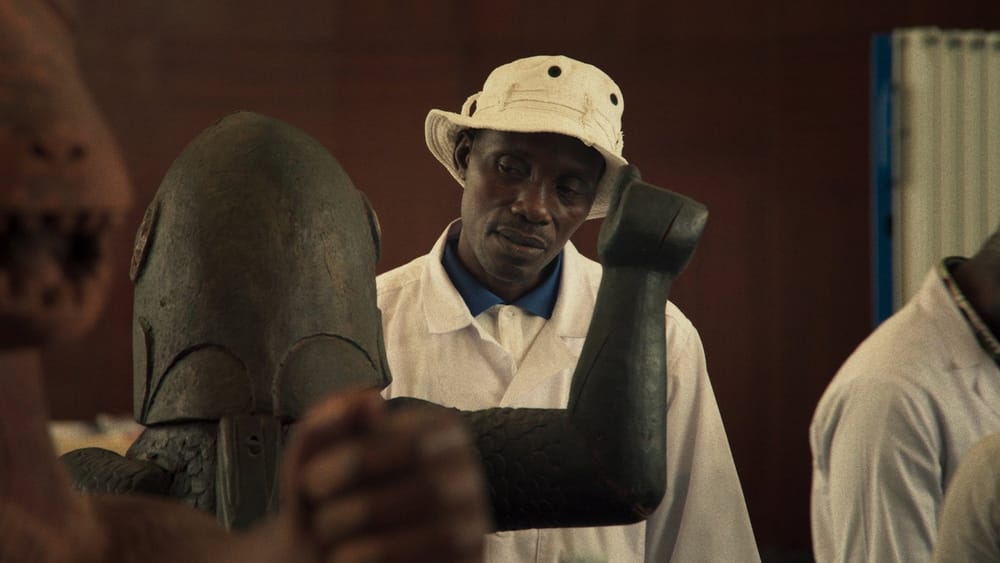“I am the trace of the trance… what if they don’t remember me?” – Number 26.
Mati Dop knows about ghosts. The multiple spectres haunting cultures and continents. The voices assembled in the dark which whisper “Do you remember?” pulling at the conscious and unconscious. Diop’s fiction debut Atlantics (2019) spoke of contemporary Dakar and interstitial reality within a Senegal still reckoning with its place as a post-colonial nation. Similarly, Dahomey, a staged documentary about the 2021 return of twenty-six French colonial plundered pieces of cultural treasure to Benin in West Africa, confronts the tension between the ancient heritage of the Beninese and the attempt to decolonise from France.
Diop begins her poetic and incisive film in France. It is night and next to a ferry is a street stall selling light-up Eiffel Towers. The symbol of modern Paris can be reduced to mass produced trinkets without giving up what France ‘means’. It is not the same for the cultures and countries who have been dominated and defined by Europe through colonialism, war, and control of the narratives surrounding the people. The continual othering of the physical, historical, and psychological West African becomes manifest in the symbolic voice of one of the artefacts – a statue of a King stolen in the French invasion of the Kingdom of Dahomey in 1892.
Speaking in Fons from an eternal darkness, the artefact designated 26 (of over seven thousand) wonders if the return ‘home’ after one hundred and thirty years will be an end to his imprisonment. Is he going home at all as the Kingdom of Dahomey is now the Republic of Benin. Does another journey across the Atlantic, a journey of repatriation, signal liberation or reinforce erasure? The musings of 26 (scripted by Malkenzy Orcel) overlay the process of the artefacts being packaged in Paris and arriving in Benin to celebration from some, and energised debate from others.
Experts at the museum in Benin carefully unpack and catalogue the treasures which include statues of Kings Ghezo, Glele and Béhanzin. It also includes a throne which gives context to Dahomey as an expansionist slaving Kingdom. A series of funereal ornaments, laceworks, and wood carvings are inspected with care. Care that it is revealed has been overseen closely by the government and French authorities. Benin previously considered incapable of conserving its own cultural artefacts.
Diop splits her documentary into an observation of the external unpacking and housing of the treasures, a purposeful but impressionistic collage of Benin, a meditation on permanence and transience, a study of Beninese people looking at the artefacts, and a rigorous debate undertaken by the impassioned and intelligent students of the University of Abomey-Calavi about how the repatriation is to be viewed in their wider goal to decolonise. “I am in the present under construction,” intones the voice of Number 26.
The present is part of an infinite that is struggling to find a way to express itself. One of the students speaks of how there is no way for her to speak in her own language – she must express herself in French, in the tongue of the people whose philosophers and writers, Rousseau and Voltaire spoke of liberty from tyranny and whose works are being sold in street markets. Another student says that he knows the stories of Hollywood; he understands James Cameron’s Avatar, but he doesn’t know about the history of Dahomey Kings. Another asks what purpose museums serve when the people of Benin aren’t guaranteed three meals a day. Another questions the notion of the museum and gallery itself as a European construct as it disconnects the artefacts from their religious purpose and lessens their voudon power. More speak of the paltry nature of only being afforded twenty-six pieces out of many thousands and if it is simply an exercise in political public relations between France and the current government. How long do they have to wait for their history to be ‘gifted’ back?
What constitutes heritage in itself is interrogated – the tangible, the symbolic, the historic. It is material and non-material. To know that one is not the descendent of slaves but the descendent of Amazons is power and it is an act of continuity now undeniable. If a child sees the figure of Béhanzin in war regalia what does that mean as they build their understanding of being West African?
Josephine Drouin Viallard’s camera glides across Porto-Nova at night as the voices of the past speak of the sea, of the heat of the tropics, of the foliage waiting to unfurl in a daytime they thought they would never again see. The score and sound design evokes a sense memory of death and rebirth. During the day Porto-Nova bustles with construction. Dignitaries arrive to celebrate the return of the treasures – a woman speaks of the return of African people to Benin – a homecoming for the displaced and stolen. Diop focuses on open windows, curtains moving in the wind, empty spaces, and spaces where the young people gather in the city creating their own momentum.
Mati Diop suggests that the Kingdom of Dahomey is not gone but is found in both concrete and liminal spaces – yet somehow less important than the spaces are the faces of the West Africans and the eyes that regard and (re)create themselves along a continuity of understanding. “I am the face of the metamorphosis; I see myself so clearly through you. Number 26 does not exist. I resonate through infinity,” speaks the ancestor from a position of omnipresence. “I never left. I am here.”
Dahomey is elegant and essential, poetic and profound. Mati Diop has created a testament to a people scarred by the permanent impact of the subjugation of self-ownership and determination under colonialism and infused it with ghosts who become guides and are guided by the generations of the future. Haunting and percipient, Dahomey is documentary filmmaking in its most ecstatic form.
Director: Mati Diop
Writer: Mati Diop
Producers: Mati Diop, Eve Robin, Judith Lou Lévy
Cinematography: Joséphine Drouin-Viallard
Editor: Gabriel Gonzalez
Music: Wally Badarou, Dean Blunt
Streaming Availability:

